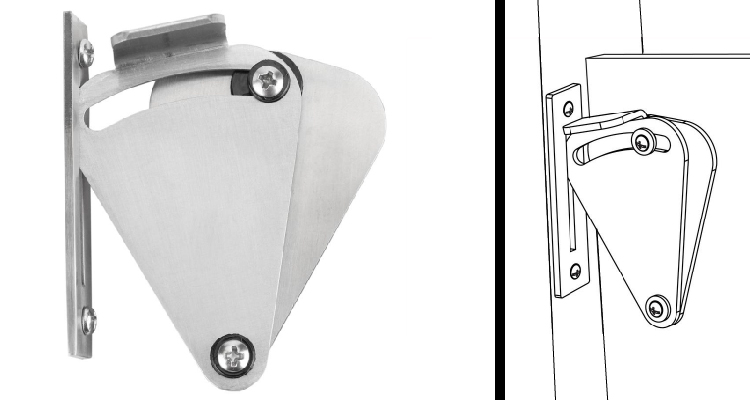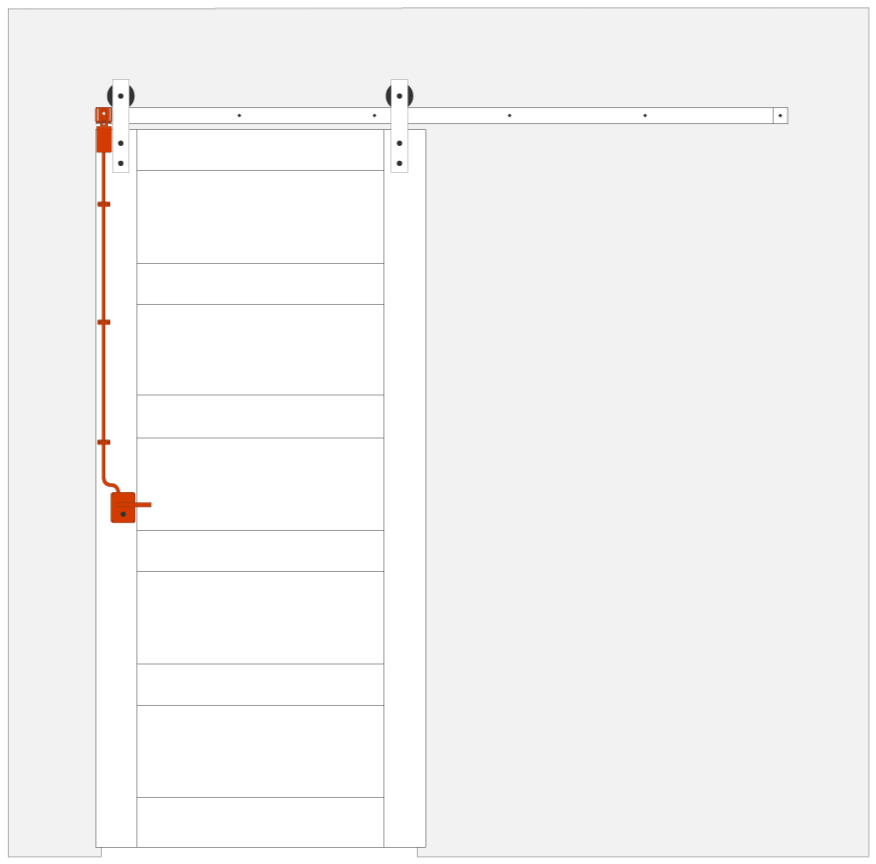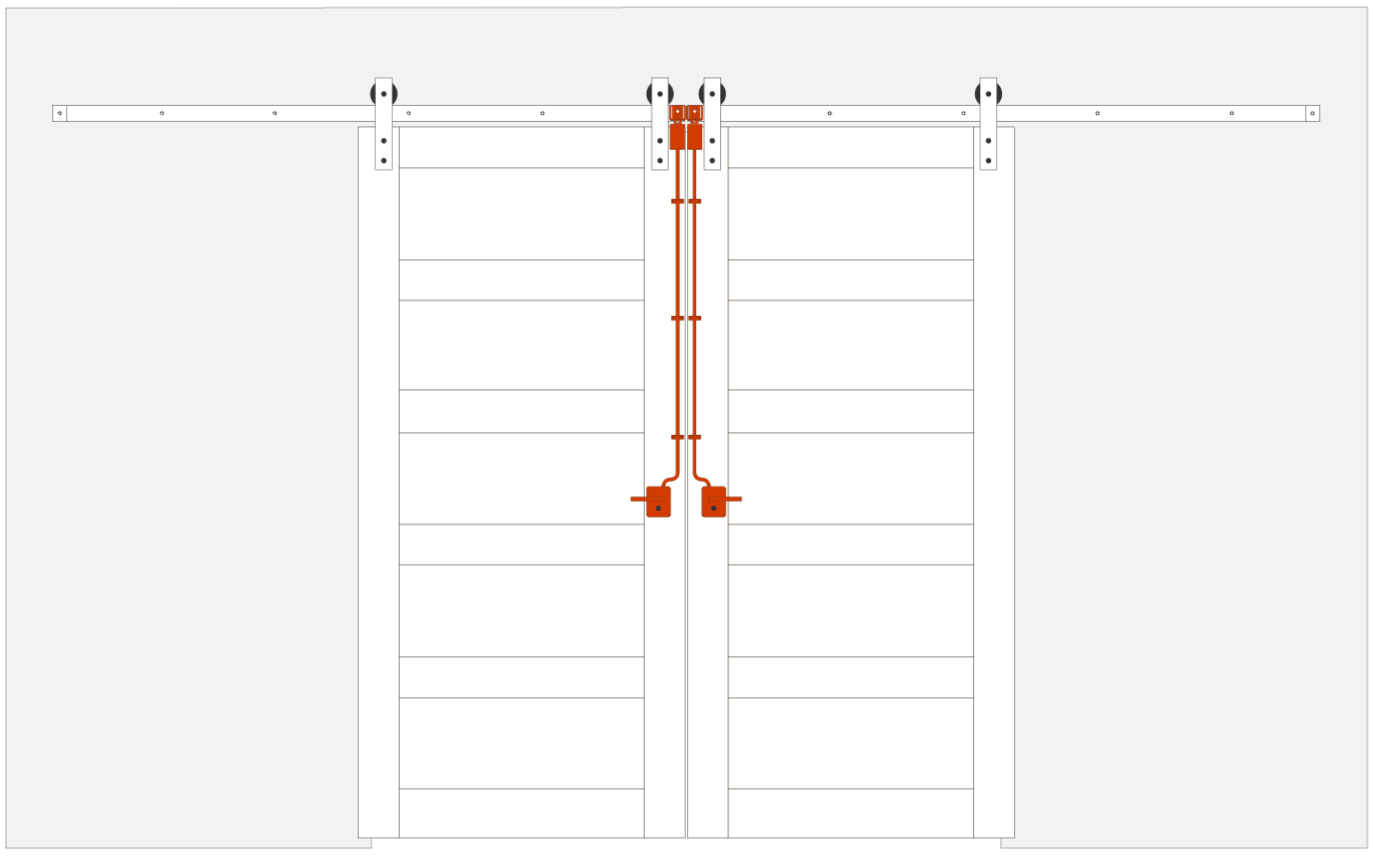Before purchasing a
sliding door, many homeowners research to understand exactly how to lock a barn door. Is it really possible or
practical? And, if so, how can they ensure that safety and privacy are all achieved from a panel that doesn’t
function with a traditional lock? Sliding barn doors are amazing accent pieces that can bring cozy
country character and rustic style to any space. And as you may already know (or you’re about to find out), they
make a great DIY project.
But as cool and charming as they may be, the last thing
you want to compromise is your privacy and overall home security, right? Let’s face it, no guest wants to use a home
bathroom that doesn’t lock. So if you’re asking yourself, can barn doors lock? The answer is yes!
Here are a
few considerations to keep in mind when choosing locking mechanisms for your barn door.
How to Lock a Barn Door
- Consider the Room
- Decide Barn Door Type
- Install Locking Mechanism
Since the locks for a barn door are a
bit less familiar than those of a swinging door, it’s best to do your research and ask questions so that you
fully understand the process of choosing and installing locks for sliding doors. First, it’s important to begin by
understanding exactly how to lock a sliding barn door.
Can You Lock a Sliding Door?
Whether you’re looking to secure a
standard, single door to its jamb or trying to figure out how to lock a double barn door, the answer is a
resounding “Yes!” It is possible to lock a sliding door.
The magic
of a barn door latch spans across several well-designed examples of locking door hardware. Over the years,
craftsmen have created many, many types of sliding barn door locks but the list below features the most
popular.
Rustica Door Latch +
Lock—With Rustica’s
original, self-latching door lock, homeowners can lock and unlock their
sliding barn door from either side with ease. With its unique design, this particular door lock requires neither
wall nor door jamb drilling, as the hardware is
installed into both the door panel and its track system. This design is one of
two Rustica latch locks that can be purchased in multiple
finishes, such as brushed steel and oil rubbed bronze. When purchasing this particular locking hardware, make
sure that your roller system is compatible.
Barn
Door Teardrop Latch— A tear drop latch consists of two main features. First, a
piece of slotted hardware is installed flush against the wall or jamb. Second, a triangular piece is drilled
directly into the barn door panel. When moving the triangular piece into a locked position, the hardware will
fall neatly and securely into the slotted latch. The tear drop latch is available in finishes from flat black to
barn red.
Hook and Eye Latch—Rustica offers two options for
hook-and-eye-style latches: the Stainless Steel Cabin
Hook and
the Barn Door Hook. In this system, a curved hook securely
falls into a round latch. Hook and eye latches are subtle and simple forms of locking mechanisms that secure a
door to a wall or to another door in the case of biparting double doors.
Hasp Lock—This lock isn’t currently offered by Rustica,
but it is a very common choice for a sliding barn door latch. A hasp lock is crafted from a metal plate with a
loop called a staple and a slotted hinged plate. The hinged plate, which is attached to the door panel, folds
towards the jamb’s plate, letting the loop pass through the slot until the two plates rest one on top of the
other.
Barrel Slide
Bolt—Though Rustica does
not at this time offer a
barrel slide bolt system, these types of locks are compatible with Rustica’s barn doors. The face plate of this
system includes a cylindrical socket with a catch plate into which a barrel slide. Sometimes the barrel can be
tubular or rectangular, depending on design style. The face and cylindrical sockets are usually drilled
into the door while the barrel is drilled into the door jamb or the wall (in the case of a sliding panel). This
lock can also be unlocked from the other side of the panel by using a key, so this type of lock is a good
security lock.
Cane Floor
Bolt—This type of
bolt lock works very closely to how a barrel slide bolt functions, except the catch plate is installed into the
floor instead of the door frame. The barrel moves vertically downwards when moved into a locked position. Unlike
the barrel lock, however, a cane floor bolt can only be locked and unlocked from one side of the
door.
One
amazing feature of the above locks is that many are customizable and can be crafted to match your existing
hardware, like barn door
pulls and handles.
There’s no need for your door to look mismatched, even if installing the lock is a bit of an afterthought or if
you’ve purchased your pull hardware, track system, locks, and door panels from more than one
vendor.
How to Lock a Sliding Barn
Door
Consider the Room
The first thing to consider when
purchasing a sliding barn door lock is to analyze the specific needs of your room.
A few
questions to ask yourself include: do you need to be able to lock your door on either side? Is there a design
detail that you hope to replicate in your lock? Is privacy and security your main priority, or are you more
concerned with how the barn door hardware looks?
Let’s take
a look at a few examples below to see what each type of room requires:
Bathrooms
A bathroom requires a privacy lock on the interior
of the door, something that is really non-negotiable. Just as locking the bathroom
barn door from its exterior
is generally not something a homeowner needs to worry about, security is not as much of an issue as
privacy is.
Because of
these factors, something simple like a hook and eye latch or a teardrop latch would be
perfect for this room. However, in the case that you do want to be able to open your sliding bathroom door from
either side (an understandable situation for a kid’s bathroom), you’ll want to consider an option like the
barrel slide bolt or the Rustica Door Latch + Lock.
For more
ideas and suggestions on how to use a barn door in a bathroom, check out our Barn Door for
Bathroom post.
Bedrooms
Similar to a bathroom, a bedroom with a
sliding door requires a privacy lock. You’ll probably also want the door lock to be discreet in design or to
work seamlessly with your bedroom decor. Both a teardrop latch lock and a hook latch are subtle in their size
and features, making either a great option for a bedroom lock.
Exterior
Spaces
Front entry
doors and back doors require a
bit more security. For any door with an exterior entry/exit point, consider installing the barrel slide
bolt, which can be unlocked from either side by using a key.
Other
exterior door panels that aren’t primary entry and exit points can also be locked. Barn panels functioning as
garage doors can be locked securely and safely, just as a patio door can be fitted with a barn door latch
lock. For both of these doors (and similar panels) you’ll need to decide the extent of security you
desire. A barrel slide bolt with its key lock would be ideal to keep intruders out, but if you’re not
too concerned about safety, something like a cane floor bolt or hook and eye latch will do the
trick.
Interior Spaces
There are many other rooms within a home
that might require a lock. Kitchens, basements, or offices are all candidates for desired privacy or security.
An
interior door like a closet, pantry, basement
door, cabinet, or office door can be crafted to function with any of the locks previously mentioned. However,
most homeowners want their barn door locks and barn door latches to be discreet or match the interior design of
their home.
Rustica
provides locks that span some of the most popular interior design themes. Our hook and eye latches boast a
rustic design, while the teardrop latch is sleek, modern, and customizable. The Rustica Door Latch + Lock is an
excellent choice for homeowners who admire an industrial look.

For rooms that have a steady flow of people traffic, you may want to opt for an
entry sliding door
lock. Keep in mind that entry sliding door locks come in right-handed and left-handed options. Depending on
which way your door slides (if it’s a single-hung sliding door) or whether you’re a righty or a lefty may determine
your choice if you choose this type of door lock.
If you’re locking a door from the
inside (such a bathroom or bedroom), aesthetics matter, but functionality, privacy, and safety are important
features to consider, too. A teardrop sliding door lock is one option to consider for added privacy. The lock
mounts to a door jamb to keep out prying eyes and keep barn doors shut.

Decide
Barn Door Type
Once you
have a better understanding of your room’s locking requirements, you’ll want to choose a door type. Most of the
doors below can be used with any locks, aside from a few exceptions.
Standard Barn Door—A standard sliding barn
door features one panel
sliding along one track. Both corners of the panel are attached to the track with their own hanger. This
door can lock into the wall, floor, or to its track.
Biparting Barn Door—One double barn
door option is a set of
biparting panels. This system includes double door panels running along a singular track. Biparting doors pass in front of the other door when in an open
position and meet in the middle of the door opening when closed. These doors will lock against one
another, to the floor, or to their track systems.
Bifolding Door—Bifolding
doors are double doors that run
along a singular track. This particular type of door consists of panels that fold over one another when
open. These doors will also lock against one another.
Bypassing Barn Door—Double doors slide along their own tracks,
meaning a double-track system and a total of four hangers is required. Bypassing
doors act as their name
suggests—the panels pass in front of one another as they open and close. These doors work best with
Rustica’s self-latching door lock or a cane floor bolt since the door panels aren’t flush with one
another.
Pocket Door—Pocket doors can be single or double barn doors that
run along one track. The panels in the pocket door system slip into an opening in the wall, like a pocket.
These panels will lock to one another just like other biparting options.
Shutter and Cabinet
Doors—Shutter and cabinet doors can be crafted with
the same features as a standard size exterior or interior barn door. These doors can fall into the
standard, biparting, or bifolding categories and work best with hook and eye or tear drop
latches.


How To Install Lock for Sliding Barn Door
The installation process for
locking mechanisms will look different depending on the specific design. Sometimes you’ll be drilling into the
jamb and sometimes into the floor. You may need to attach hardware to your panel, but there are other times
you’ll need to install it directly into the sliding door track system.
It is important to
understand the parts of a
door so you’ll know what to
drill into and what to avoid. Rustica makes this easy by sending specific instructions for your DIY, at-home
installation.
Follow the instructions
included with the barn door—these are specific to the barn door you purchased. While not all barn doors will
follow the same steps, there are a few helpful tips you can refer to during the barn door lock and latch
installation process:
1. Remove the Door
Gap—Attach a thin, wooden board
where your wall or jamb hardware will be installed. The door thickness, contrasted with the wall or jamb’s
depth, doesn’t allow for hook and eye, teardrop and latch, or bolt and catch plate to meet without the help of
this board. This will also remove any door gap that might be uncomfortable for a bathroom or bedroom setting.
This tip is most helpful for standard door panels that will not be locking to another door.
2. Create
Security—In addition to installing
the lock itself, a homeowner can also choose to add a blocking bar to create more security. This blocking bar
slips into the door’s track system, preventing anyone on the outside from sliding the panels open.
3. Lock
Placement—According to most building
codes, locks need to be placed between 34-48 inches above the floor.
4. Measure, Mark,
Drill—As with any type of hardware
installation, it’s always important to measure your placement, mark your screw holes, and then start drilling.
This will save you a lot of frustration in the end!

How Do You Lock a Barn Door from the Outside
When you install a locking latch on a barn door, most styles
are simply providing privacy by locking from the inside. Many times, for interior barn doors, you simply want the
barn door to stay closed so that it can’t be slid open at an inopportune time. However, depending on what you are
keeping inside or who you are trying to keep out, locking a barn door from the outside is necessary. So, how do you
lock a sliding barn door from the outside?
The first thing to realize is that if you want to lock a barn door
from the outside, you need to use a sliding barn door lock with key. That leaves you primarily with the barrel slide
bolt locking mechanism. A barrel slide bolt is a security lock for your sliding barn door. This means you can lock
your sliding barn door from either side. If you want to lock the barn door from the outside, you can use the key to
engage the lock. If you’d rather lock it from the inside, then you can use the bolt portion to engage the
lock.
Slide, Lock, Enjoy!
In addition to this already simple process,
Rustica makes it even easier to find the perfect lock for sliding door panels with our hardware kit options.
These kits allow you to purchase your panels, track system, and hardware (including locks) at the same time.
This makes adding a compatible locking barn door to your newly renovated bathroom or bedroom even
easier.
If you are
looking to add a lock and latch to a sliding door for your bathroom, bedroom, and beyond, check out some great
barn door ideas throughout Rustica.com. Once you start browsing, you’re sure to start daydreaming about all the
barn door possibilities throughout your home.












